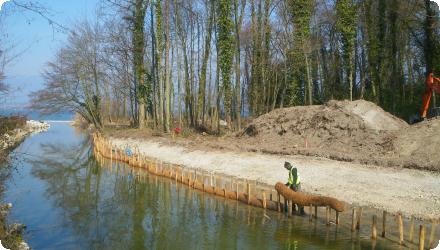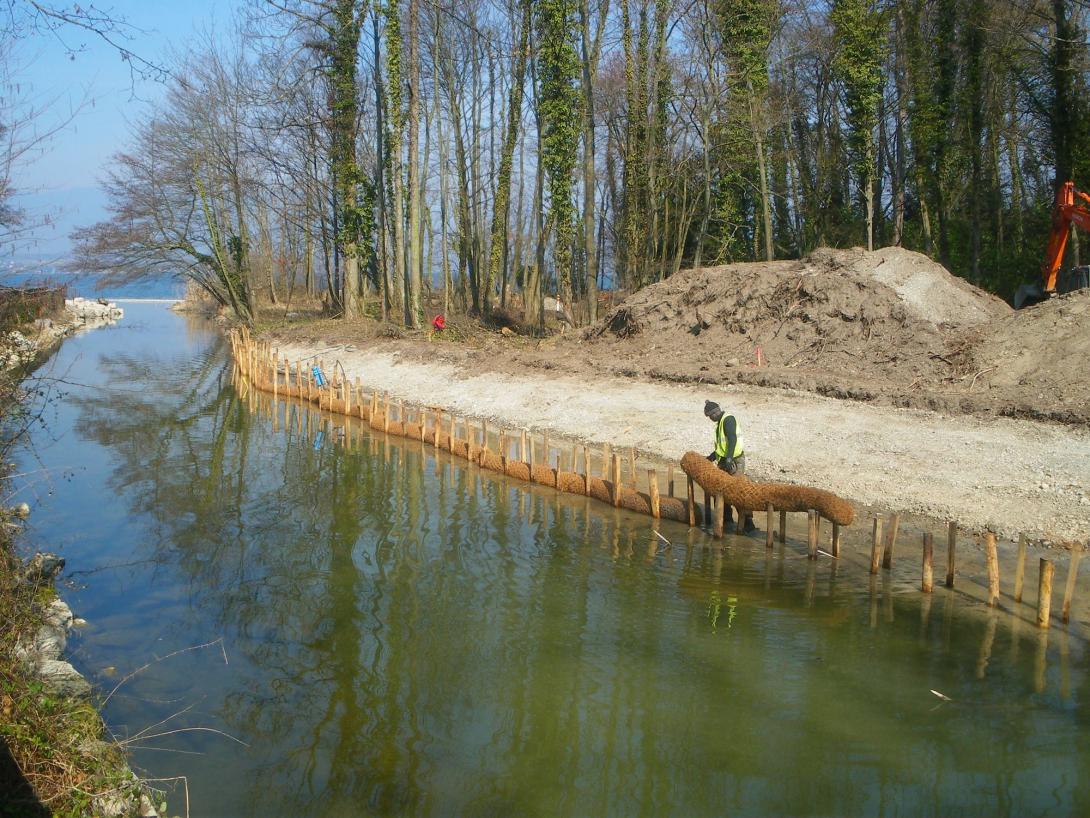Last update
2025
Summary
Hermance is a French–Swiss transboundary river. Since 2006, within a cross-border river programme led by SYMASOL with support from the Canton of Geneva, restoration has re-meandered the channel, widened the mouth, renaturalised the bed and banks, replanted riparian vegetation, and used the Mermes marsh as flood-storage via a retention pond ; reducing flood risk for ~100 homes and reconnecting people to their river with a riverside path (opened in 2017). More recent records show the programme extended in phases through 2016–2017, reaching ~3 km of restored river in Veigy-Foncenex, with a total budget reported at €2.5 M (excl. tax). Cross-border works included the 2010 renaturation of the Pont-Neuf–Pont-des-Golettes reach and the 2011 revitalisation of the river mouth. Complementary lacustrine actions created/reinforced reedbeds on the French shore at Chens-sur-Léman (2012, 2016). Flood-risk management was strengthened upstream by a ~12,000 m³ flood-retention basin. Ongoing follow-up includes a 2021 hydrological/hydraulic review of the Hermance dams in Veigy-Foncenex to check performance and safety. Overall, the project combines flood protection, ecological recovery and public amenity at a transboundary scale.
Position
Latitude
46.271137
Longitude
6.273155
Project
NWRM
National Id
France_02
Installation date
2006-2012
Implementation Status
Contact
Anaí¯s HANUS, ACTeon
RBD code
FRD
Transboundary
1
Photo gallery
Location of the project
Veigy-Foncenex reach between Pont des Soupirs and Pont de l’Hermance, plus the Lake Geneva delta between Chens-sur-Léman (FR) and Hermance (CH) at the river mouth.
NUTS Code
FR71 - Rhône-Alpes
Project's objectives
The objectives are renaturing 4,4km of artificialised river, improving water retention capacity of a 5ha marshland.
Involved Partners
| Authority type | Authority name | Role | Comments |
|---|---|---|---|
Climate zone
cool temperate moist
Temperature
10
Precipitation
1150
Elevation range
441 m
Vegetation class
Agricultural land and forests along much of the corridor; extensive reedbeds (roselières) on the Chens-sur-Léman lakeshore between Hermance and Port-de-Tougues; riparian woodland near the mouth.
Water bodies: Ecological Status
Poor
Water bodies: Chemical Status
Good
Water quality status
Historic sewage discharges and misconnected wastewater, diffuse agri pollution, low summer flows; past chlorination at Hermance STEP sterilized the lower reach. STPs at Hermance (CH) & Veigy (FR) were later removed.
Project scale
Meso
Project scale specification
Multi-kilometre river reach across communes and a transboundary delta; basin-level retention basins; coordinated via a cross-border River Contract rather than a single site.
Performance timescale
1 - 4 years
Project area
4320
Area subject to Land use change or Management/Practice change (ha)
7,5
Size
13,5
Size unit
km
Lifespan
100
Multifunctionality: flood-risk reduction, ecological restoration, public access (pathways).
Give room to the river: widening, re-meandering/renaturalization, bank softening, fish passage.
Storage/retention: two flood-retention basins upstream, incl. a ~12,000 m³ basin formed by an earthen barrage; additional structure at Marais des Mermes. (Return period not specified in accessible docs.)
Give room to the river: widening, re-meandering/renaturalization, bank softening, fish passage.
Storage/retention: two flood-retention basins upstream, incl. a ~12,000 m³ basin formed by an earthen barrage; additional structure at Marais des Mermes. (Return period not specified in accessible docs.)
Biophysical: low gradients and historical canalization; wetlands (Mermes, etc.); lake-delta dynamics; summer low flows; space constraints in urban sections; utilities relocations.
Constraints: very fragmented land tenure (~65 riparian owners); lengthy land negotiations.
Favourable: presence of marshes enabling retention; available widening room in some reaches.
Constraints: very fragmented land tenure (~65 riparian owners); lengthy land negotiations.
Favourable: presence of marshes enabling retention; available widening room in some reaches.
Areas relevant to retain water have been identified; the Mermes marshland appeared as an interesting retention place.
Total cost
1831600
Costs investment
357800
Costs investment information
343800€ have financed the creation of retention areas along the Hermance river
Costs land acquisition
64000
Costs land acquisition unit
€ (total value)
Costs operational
211300
Costs operational information
About 96000€ have been spent for restoring the banks of the Hermance river (9,63€/m), corresponding to about 16 000€/year during six years. 166800€ have been spent per year during six years to restore and renature the riverbed. 134331€ have been spent for widenning an discharging section, that is to say 22400€ per year. About 100€/year have been spent on supporting grass buffer implementation in the vineyards above the river
Costs operation maintenance
237300
Costs operation maintenance information
About 96000€ have been spent for restoring the banks of the Hermance river and 1000800€ have been spentto restore and renature the riverbed. 134331€ have been spent for widenning a discharge section. 5128€ have been spent for implementing grass buffer strips in the vineyards above the river, 10 000e/year are spent on haying in retention ponds.
Costs maintenance
26000
Costs maintenance information
About 96000€ have been spent to manage the newly planted vegetation along the Hermance riverbanks. Moreover, haying in retention ponds require about 10 000€/year.
Information on Economic costs - income loss
Famers have received indemnisations for yield losses
Financing authorities
Type of funding
Sub-national funds
Type of funding
Sub-national funds
Type of funding
Sub-national funds
Type of funding
Local funds
Type of funding
Local funds
Type of funding
Local funds
Type of funding
EU-funds: Rural development funds
Type of funding
EU-funds: Cohesion and regional development funds
Compensations annual
2500
Compensations annual information
About 14000€ have been received by farmers for income losses
Compensations nr beneficiaries
3
Compensations nr beneficiaries information
Farmers
Policy context
Implemented under the Transboundary River Contract “Sud-Ouest Lémanique” (2006–2012) led by SYMASOL, with the Canton of Geneva as a key partner. Aimed to reduce downstream flood risk, address morphological degradation and water-quality issues, and restore public river access; aligned with SDAGE Rhône-Méditerranée. Geneva reports the Hermance mouth among embouchures renatured (2011).
Land ownership
Mixed. The river corridor crosses many private parcels (formal agreements signed). Works at the mouth involved public/communal areas near Chens-sur-Léman; cross-border stretch includes cantonal/public domains on the Swiss side.
Community involvment
Yes
Design consultation activity
| Activity stage | Name | Key issues | Comments |
|---|---|---|---|
|
Design phase
|
Information letters
|
||
|
Screening phase
|
Private interviews
|
||
|
Screening phase
|
Public meeting
|
||
|
Implementation phase
|
Public meeting
|
Policy target
| Target purpose |
|---|
|
Peak-flow reduction
|
|
Increase Water Storage
|
|
Erosion Control
|
|
Improved Biodiversity
|
|
Oher Societal Benefits
|
Target Remarks
Renature ~4.4 km of artificialized channel; enhance retention capacity of ~5 ha marshland; reduce flood risk for ~100 houses; re-meander/renaturalize ~2.3 km; widen the mouth; plant riparian vegetation.
Policy pressure
| Pressure directive | Relevant pressure |
|---|
Policy impact
| Impact directive | Relevant impact |
|---|
Requirement directive
| Requirement directive | Specification |
|---|
Contractual arrangements
1
| Arrangement type | Responsibility | Role | Name | Comments |
|---|---|---|---|---|
|
Contractual agreement
|
Contracts with private owners
|
Contractual arrangements have been signed with private owners about banks management
|
Part of wider plan
1
Wider plan type
| Wider plan type | Wider plan focus | Name | Comments |
|---|---|---|---|
|
Local
|
Water
|
Contrat de rivière transfrontalier Sud Ouest Lémanique
|
The plan defines water maagement strategy on rivers located in a watershed
|
|
Regional
|
Water
|
SDAGE Rhône Méditerranée
|
The SDAGE defines the main objectives and strategies necessary to reach the good status for water bodies in 2021
|
Water quality (pesticides, nitrogen and metals) is monitored. Water flow and ecological quality are measured punctually.
A monitoring station was built in 2024, in order to follow flow rate and water quality.
HER 379 and HER380
Catchment outlet
Comparison to the state before the implementation of the measure
The main benefit is social: people walk along the river and walkaways enable them to link the two sides of the city. People seem to make again the river their own and to became more aware of river management issues.
Information on retained water
Flood: storage basins (incl. ~12,000 m³) and marsh restoration reduce peak flows; Geneva reports households/school moved out of medium-danger zone at Hermance.
Hydromorphology: widened mouth restored partial alluvial dynamics; re-meandering/bed diversifications increased habitat heterogeneity.
Connectivity & low flows: fish passage improved; marshes support baseflow during drought periods.
Hydromorphology: widened mouth restored partial alluvial dynamics; re-meandering/bed diversifications increased habitat heterogeneity.
Connectivity & low flows: fish passage improved; marshes support baseflow during drought periods.
Ecosystem erosion control
1
Water quality overall improvements
Negative impact-WQ deterioration
Information on Water quality overall improvements
Water quality has decreased during the implementation of the measure, but his can be linked to other factors (pressures...). Only hydrobiological quality (downstream) and metals (mouth) have stayed at the same level.
Soil quality overall soil improvements
Not relevant for this application
1
The river renaturation, banks restoration and riverbed works have benefited to natural habitats; fish population status have improved along the river: it passed from disturbed to excellent in one station, and to good in another one, between 2002 and 2011. Moreover, new plants can now be observed along the river.
10 years after the restoration work, if a clear return of fauna and flora has been observed, there is still no population of fish of fishing interest; further waiting is required.
10 years after the restoration work, if a clear return of fauna and flora has been observed, there is still no population of fish of fishing interest; further waiting is required.
Ecosystem impact climate regulation
No information available
Key lessons
The case study provides an example of a bundle of measures which can be implemented to achieve several purposes; it does not gives much facts on biophysical impacts but provides interesting elements about succes and barrier factors; in this case as in many others, dealing with private owners in order to implement the measures on their properties have been the main difficulty.
Success factor(s)
| Success factor type | Success factor role | Comments | Order |
|---|---|---|---|
|
Successful coordination between authorities
|
main factor
|
<p>coordination between stakeholders, particularly in a transboundary watershed, was essentiel to guarantee the success of the implementation</p>
|
1
|
|
Financing possibilities
|
main factor
|
<p>Existing financing posibilities, including one from Geneva Canton, was a main succes factor</p>
|
2
|
|
Other
|
main factor
|
<p>Contractors change for the different works; the SYMASOL considers that it is a good thing</p>
|
3
|
Driver
| Driver type | Driver role | Comments | Order |
|---|---|---|---|
|
Balancing different objectives
|
main driver
|
Local authorities decided to deal with their rivers management after some studies that showed the pressure of urbanisation and the need to restore water quality. They made a first preliminary dossier that led them to implement a River contract and create the SYMASOL.
|
1
|
|
Legal obligations
|
secondary driver
|
Objectives fixed by the SDAGE asked for implementing a management strategy
|
2
|
Transferability
Highly transferable to small cross-border or peri-urban rivers, but expect protracted land negotiations, multi-jurisdictional permitting, and the need to couple morphology with wastewater fixes and wetland management; plan O&M for created retention areas.
Source(s)
English

